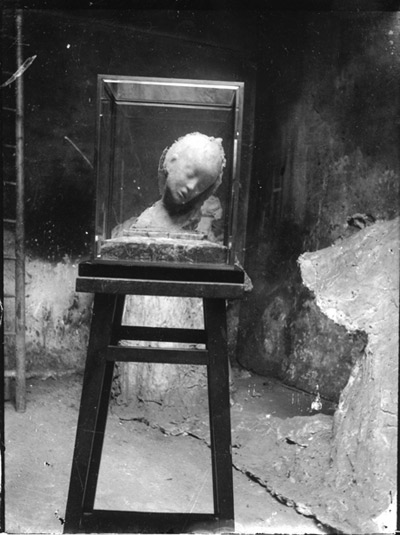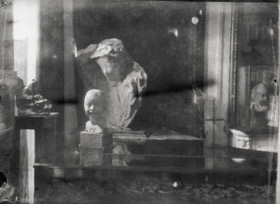
Medardo Rosso Enfant malade, wax, 1898 [model 1895], in the studio
in boulevard des Batignolles, Paris, with Paris la nuit, plaster, in the background;
photo Rosso 1898.The work is presently in Dresden, Staatliche Kunstsammlungen
© Archivio Medardo Rosso, Barzio
|
|
PEGGY GUGGENHEIM COLLECTION
Palazzo Venier dei Leoni
701 Dorsoduro
30123 VENEZIA
INFORMATION
Tel. +39 041 2405 411
Fax +39 041 5206 885
Site: www.guggenheim-venice.it
OPENING HOURS
10am-6pm, closed Tuesdays
ENTRANCE FEES
Euros 10; euro 8 senior (over 65),
euro 5 students; 0-10 years free
CURATORSHIP
Paola Mola and Fabio Vittucci
PRESS CONTACT
Alexia Boro, Tel : +39 041 2405 404.
E-mail: press@guggenheim-venice.it

|
Medardo Rosso (Turin, 1858 – Milan, 1928) is a renowned artist, widely studied and firmly consolidated in the European scene of late 19th-century sculpture as a precursor of modernity. And yet Rosso remains unknown for the most significant part of his production. The systematic and detailed scrutiny of documents, papers and letters from the archive, instigated by Danila Marsure Rosso a few years ago and carried out by Paola Mola and Fabio Vittucci, the curators, with further research in Italy and abroad, has opened new unexpected horizons that go against the perceived image of the ‘Scapigliatura’–Impressionist sculptor.
A cousin of Marcel Duchamp?
By nature Rosso was a hidden talent: he skilfully concealed all of his photographic work, he exhibited his most treasured works, such as Madame X or Yvette Guilbert, more than fifteen years after their creation and, like Marcel Duchamp, destroyed all of his correspondence at the end of his life. From the very start of his career he cleverly manipulated his biography, contributing to the definition of an unequivocal view of his art accepted unquestioningly by historiography to the extent that the entire 20th-century output of his creative energy has remained unheard of until now. The term ‘transient’ can define Rosso’s sculpture in relation to ancient sculpture rooted in the landscape, indicating places: the obelisk, the altar; but can also distinguish it from 19th-century or even 20th-century sculpture on bases or pedestals. Rosso is changeable, mobile, a transparent and shimmering showcase.
The question of time and dating
The exhibition traces the rediscovery of the complex contemporary aesthetics of A precursor of modernity whose complex aesthetics need to be rediscovered through sculptures, waxes, plasters, bronzes, photos and previously unseen documents. The project has been realised in association with the Museo and Archivio Medardo Rosso in Barzio (Lecco), which houses the entire legacy of the sculptor’s works and archive, bequeathed in its entirety to his great-granddaughter, Danila Marsure Rosso. The decision to exhibit a selection of 22 documented sculptures, including Madame X (wax on plaster, 1896), Yvette Guilbert (glazed plaster, 1895), La Rieuse (wax, 1890) and Bambino malato (wax, 1889), reveals the complex task of dating and reconstructing Rosso’s artistic production. Time was of little consequence to Rosso: sometimes the artist himself would get the dates of his works muddled up, as though for him the work were a fluid thing that would last a lifetime in sculpture or in photography.
Giving space to photography
On a specifically historiographic level, a lot of new information has emerged that will put an end to debated questions in the world of 20th-century art, such as the dating of Madame X; events will be clarified, such as the fate of Impressione d’omnibus, which had a very different end to that of its destruction on a journey to Venice in 1887, or the fate of the large Paris la Nuit plaster. Furthermore, his photographic work is given prominent space in the exhibition, with over 80 photos coming from the Archivio Rosso, complementing Paola Mola’s latest work Rosso: Trasferimenti, which considers the question, central in contemporary art, of the relationship between Sculpture and Photography. Perhaps the most important premise of this exhibition will be to clarify the aesthetic quality of Rosso’s production with the presentation of incontrovertibly signature works, whose history will be reconstructed from their conception, drawing on the studies and research carried out for the Catalogo dell’opera documentata backed by the Archivio Rosso and in an advanced stage of development.
Illustration; Medardo Rosso Malato all’ospedale, Petite rieuse, Femme à la voilette and Bambino ebreo in Etha Fles’ home in Utrecht, photo Rosso, 1901 ca.© Archivio Medardo Rosso, Barzio
PUBLICATION
A catalogue accompanies the exhibition with essays by Paola Mola and Fabio Vittucci, published by SKIRA, Milan.
|


